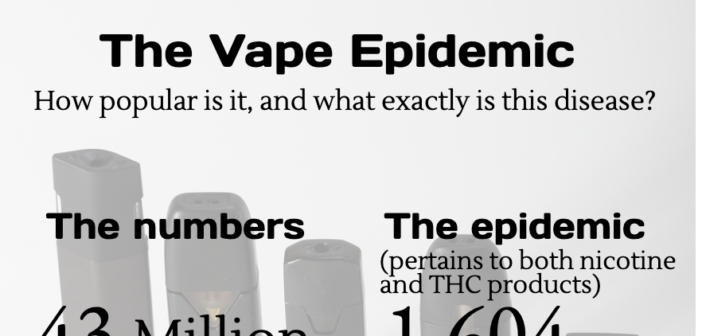Thirty four deaths related to e-cigarette or vaping use have been confirmed in 24 states.
As of Oct. 22, 1,604 cases of e-cigarette or vaping product use associated lung injury (EVALI) from 49 states have been reported to the Centers for Disease Control and Prevention (CDC).
Fourteen percent of 1,364 patients with data as of Oct. 15 are under 18 years old, 40 percent are between 18 and 24 years old, 25 percent are between 25 to 34 years old, and 21 percent are 35 years or older.

The Juul and the Suorin are two e-cigarette brands. E-cigarettes can contain nicotine, tetrahydrocannabinol (THC), cannabinoid (CBD) oils and other substances and additives, according to the Centers for Disease Control and Prevention. (Nicole Walker/B&W Staff)
The cause of lung injury is still unknown, according to the CDC, but the one commonality among all cases is the use of e-cigarette or vaping products.
E-cigarettes can contain nicotine, tetrahydrocannabinol (THC), cannabinoid (CBD) oils and other substances and additives, according to the CDC.
“(The CDC) know that there seems to be an increased incidence of THC, but not in all of the cases of vaping that have caused the problems,” said Kathleen Brehm, director of nursing at Lehigh’s Health and Wellness Center. “There’s no clear indication that one-time vape isn’t going to be the problematic situation.”
The CDC found that 75 to 80 percent of patients reported use of THC, while 58 percent used nicotine-containing products, 15 percent used products with nicotine but not THC, and 13 percent used only nicotine-containing products within the 90 days before symptoms emerged.
Nicotine is highly addictive, Brehm said, and it is present in most e-cigarette or vape products. However, one problematic issue with these products is a lack of a complete ingredient list, she said.
Jenna Lefkowitz, ‘20, a peer health adviser, said college and high school students vape and, specifically, use Juuls because they believe Juuls are a safer, better alternative to smoking cigarettes. But in reality, she said, this has never been proven.
“There are lots of different chemicals in Juuls that people really don’t know the effects of because it’s such a new phenomenon,” Lefkowitz said. “And so, I feel like with all of these recent deaths and situations going on with the Juul, it’s really opening people’s eyes to, ‘Oh wow, this actually is really detrimental to people’s health,’ whereas I feel like a lot of people didn’t know that before this.”
Negative health effects of EVALI include pneumonitis, which is inflammation of lung tissue, diffuse alveolar damage, which occurs from injury in the lung tissue, shortness of breath, cough, chest pain, fever and chills.
Brehm said many of these effects were not known until the epidemic broke out this summer. She said the American Cancer Society has data of the number of packs of cigarettes estimated to increase the risk of lung cancer, but for vaping, the data does not exist yet.
E-cigarette and vape companies were able to advertise and market to students as young as middle schoolers, Brehm said.
Peer health adviser Marissa Bruno, ’20, said the companies chose to market toward younger people because of the opportunities to exponentially increase their revenue.
“It’s kind of like a domino effect,” she said. “You’re hooked on it, and then you have to keep buying the pods and keep buying the Juuls because every time you lose one it’s $50 to buy a new one.”
According to the Food and Drug Administration (FDA), the 2018 National Youth Tobacco Survey found more than 3.6 million U.S. youth are using e-cigarettes. The data shows one in five high school students vape, which is a 78 percent increase from 2017. One in 20 middle school students vape, a 48 percent increase from 2017.
The substantial increases are hypothesized to be a result of the use of Juuls specifically because of the product’s appealing flavors, high nicotine content and size.
Brehm said she thinks more than 50 percent of the responsibility is assumed by the marketers.
“Every one has free will,” Brehm said. “I think the marketing drew a lot of people to it.”
Daniel Coraggio, ‘20, thinks the distributors of e-cigarette and vape products that allow companies like Juul to sell its products are to blame because they take advantage of the consumers.
“(E-cigarette and vape companies) know what’s going to happen to a degree, and they’re just kind of betting they can either A — maybe make enough money that it doesn’t matter, or B — just mitigate it to the point where people won’t have a problem with it, because it’s so widely used,” Coraggio said.
Lefkowitz said companies fail to warn users or provide information about what Juuls actually contain, though people often don’t seek the information out.
The environment in which e-cigarettes and vape products are used is a factor that affects students, both Coraggio and Lefkowitz said. Lefkowitz said at colleges, including at Lehigh, students carry Juuls around with them wherever they go, which entices others to also want to vape because it “seems fun” or “cool,” but they fail to recognize the repercussions.
Coraggio said he only heard about Juul after coming to Lehigh. He said he had smoked cigarettes casually before college because it was introduced to him through family members. He only started to Juul in college because he saw students on campus using it.
He said Juuls are easy to carry around and are not stigmatized like cigarettes or other bulky e-cigarettes or vape products.
“Juuling” also has a social element that encourages more to start and continue vaping.
“If one of my friends has a Juul, I’m ten times more likely to ask him for a rip,” Coraggio said.
Coraggio said once people are introduced to nicotine, the pull is like a magnet, and their use of e-cigarettes or vaping products increases.
Lefkowitz said the media worsens the issue because when celebrities and influencers smoke or vape on social media accounts, people think it is acceptable and not as serious.
“As a peer health adviser, we’ve actually discussed this in a lot of meetings recently,” Lefkowitz said. “…We’ve recently been trying to partner with the health center…we have discussed implementing some Juul information and some resources.”
The vaping epidemic and outbreaks have had an effect on Coraggio, who has noticed shortness of breath, lethargy and feeling sleepy even when well-rested. He said though he enjoys the short-term effect of a head rush, he realizes the health concerns of vaping frequently.
Coraggio said using a Juul is more dangerous than smoking cigarettes because the device can always be in a person’s possession to be used more easily and frequently. He said he often feels sick and experiences low energy for the majority of the day.
“I think they met a niche in the market…the Juul kind of offered something where it was almost socially acceptable to use nicotine,” Coraggio said.
Bruno said the solution to the epidemic for young students lies within the schools because children are not equipped with dealing with the addiction.
The Pennsylvania Department of Health delivered a statewide health advisory to urge e-cigarette or vape users to not buy products off the street, to be aware of symptoms and to seek medical attention if concerned about their health.
“Exercise caution with new products,” Brehm said. “Be wary of advertising and marketing.”
For resources for quitting, visit SmokefreeTXT online or text QUIT to 47848, Tobacco Quitline at 800-QUIT-NOW, https://pa.quitlogix.org, National Cancer Institute Monday-Friday 9 a.m.-9 p.m. or at 877-44U-QUIT, https://www.thetruth.com/articles/hot-topic/quit-vaping, Lehigh Valley Health Network Tobacco Treatment at 610-402-4845 or Lehigh Counseling for group therapy. There is also nicotine replacement therapy, which includes patches, lozenges and gum available over the counter at local pharmacies.
Emma Satin, ’21, contributed to this story.






Comment policy
Comments posted to The Brown and White website are reviewed by a moderator before being approved. Incendiary speech or harassing language, including comments targeted at individuals, may be deemed unacceptable and not published. Spam and other soliciting will also be declined.
The Brown and White also reserves the right to not publish entirely anonymous comments.